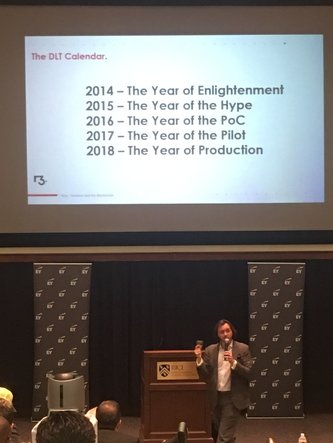By Pete Harris, Principal, Lighthouse Partners, Inc. and WSBA Perspectives Blog Curator

I pretty much agree with the blockchain adoption timeline presented by R3’s Tim Grant at a recent conference (see the photo below). Indeed, the theme for this year’s Blockchain for Wall Street education day is focused on the transition from blockchain proof-of-concepts to pilots. At the event – on November 14th – we will be presenting awards related to the Blockchain Reality in Financial Markets Challenge, which we kicked off this month. The focus of that challenge is on real pilot projects.
Moving from PoCs to pilots means more than just improving the UX or adding some functionality. Pilots will need to run in enterprise IT environments and they will need to integrate with existing systems and databases. In essence, while they might be limited in scope, pilots are as real as the systems that they will sit alongside in corporate datacenters. For this reason, I prefer to refer to them as “production pilots.”
Public cloud services can ease the deployment burden for PoCs – and even for some production systems – but many applications will be deployed and managed in house and so lots of consideration needs to be given to so-called DevOps issues, which includes understanding container technology, such as Docker and Kubernetes.
For those that want to know more about blockchain deployment, check out my extended thoughts in this article I wrote for Distributed.
Implementing blockchains will also require a rethink of existing business processes and technology architectures as they relate to data management.
Many point to the promise of blockchain to streamline reconciliations for various financial markets, but in order to do so it is likely that business processes will need to change to incorporate continuous, as opposed to end of day, matching.
Data architectures will need to be designed to make best use of blockchains – and their key immutability and single, shared data store attributes – alongside existing data systems. Just as big data technologies like Hadoop has not replaced traditional database, so neither will blockchain approaches.
I also recently wrote at length in Distributed on the data integration and management topic, and you can find that here.
For sure, rolling out blockchain pilots will not be straightforward, but approaching the technology using existing holistic approaches to systems and data management will make it (a bit) easier.
Implementing blockchains will also require a rethink of existing business processes and technology architectures as they relate to data management.
Many point to the promise of blockchain to streamline reconciliations for various financial markets, but in order to do so it is likely that business processes will need to change to incorporate continuous, as opposed to end of day, matching.
Data architectures will need to be designed to make best use of blockchains – and their key immutability and single, shared data store attributes – alongside existing data systems. Just as big data technologies like Hadoop has not replaced traditional database, so neither will blockchain approaches.
I also recently wrote at length in Distributed on the data integration and management topic, and you can find that here.
For sure, rolling out blockchain pilots will not be straightforward, but approaching the technology using existing holistic approaches to systems and data management will make it (a bit) easier.

 RSS Feed
RSS Feed